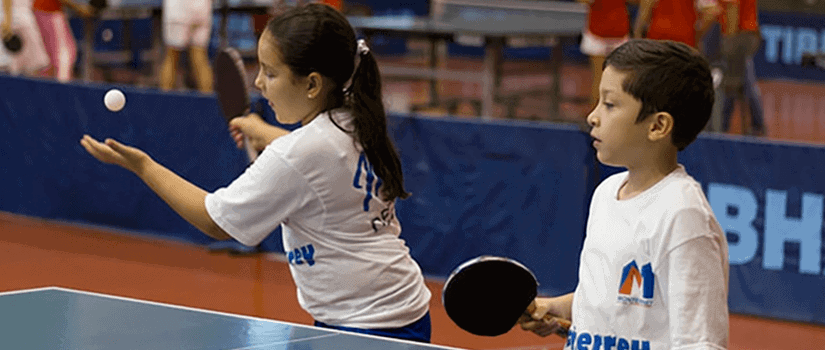
Something For The Winter
The colder winter months can make some sports difficult or impossible to continue, and many would prefer not to have to venture outdoors. Yet exercising during the winter is just as important as it is the rest of the year, and finding indoor activities that can be beneficial health-wise is therefore important. Table tennis can be a perfect activity at this time of year. It is becoming increasingly popular in the UK, with currently over 2.4 million players, although its history dates back to at least the 19th century. It evolved from the ancient game of tennis (Real tennis or Jeu de Paume), and developed after Lawn Tennis became more popular in the 1880s (International Table Tennis Federation, n.d). It is a complex physical activity, efficiently developing a number of physiological skills, and has been shown to offer benefits to cognitive functioning.
Numerous studies have shown the positive impact that table tennis can have on an individual’s flexibility, strength, speed and endurance. The physiological and cognitive demands of table tennis were outlined by Kondic, Zagatto and Sekulic (2013), who investigated how the body functions during table tennis training and competition and noted that to win a match the player needed not only excellent technique, but a good understanding of tactics, good psychology and a high level of physical strength. There is a general consensus amongst scientists that table tennis is both an aerobic metabolism sport requiring great endurance, and also an intense anaerobic metabolism sport for short periods during fast rallies (Pradas et al, 2010, Zagatto and Gobatto, 2012). Table tennis uses a significant amount of energy and a significant positive relationship has been found between player levels and heart rate, making it an excellent game for improving levels of fitness.
A Brain Game
Researchers have also highlighted additional cognitive benefits of the sport. It has been described by some as ‘high speed chess’, due to the mental aptitude required by the tactical challenges involved. One paper by Kawano, Mimura and Kaneko (1992) described the ability of table tennis to preserve far better mental ability in players in comparison to those who did not play. The fine motor control and hand-eye coordination involved when diving for the ball utilises and improves the primary areas responsible for arm and hand movement. The prefrontal cortex is further enhanced by the strategy aspect of the game and anticipating the moves of opponents, just as it would be during a chess match. This is true for all age groups, with more recent studies suggesting an even wider range of benefits, such as diagnosing autism and Aspergers in children (Bernstein, 2012).
The benefit has been found to increase in relation to the length of time the individual practices table tennis, suggesting that the sport will continue to offer continuous value in terms of physical and mental health as time goes on. As Kawano, Mimura and Kaneko (1992) note, physical exercise of any type will increase blood circulation, and therefore improve the supply of oxygen, nutrients, vitamins, and other required chemicals to the brain. Table tennis is one of the more accessible sports, requiring only moderate energy consumption for those who may be lacking in pre-existing experience or those lacking confidence in physical activity. The game can increase in intensity as the player’s skill and fitness levels develop. It is certainly far more economical than many activities, with a basic starter kit consisting of bats, balls and a portable net available for around £10. It is ideal for any age, gender, or ability level. Yet it provides an excellent work out for the whole body and mind.
Table Tennis In Schools
Considering the many advantages of the game, it is an ideal sport for young people at all levels of ability. The English Schools Table Tennis Association (ESTTA) was established in 2009 with the aim of promoting table tennis in schools. Each year, various national, inter school and intra school competitions are organised which encourage more youngsters to get involved and improve their skills. Working with teachers and students, ESTTA are helping to set up more local clubs all over the UK, which allow pupils to try table tennis and compete with others as they progress. However, in order to see these benefits in practice it is vital that table tennis is taught as a scheme of work and developed over time and not just seen as a indoor alternative activity, for use when there is poor weather.
References
- Bernstein, R.J. (2012) Table Tennis Therapy for Asperger’s Students. USA Table Tennis Magazine (1)32. Available at: https://www.t3pingpong.com/sen/[Accessed December 17th 2014].
- English Schools Table Tennis Association (2009) ‘About Estta’. Available at: http://www.estta.org.uk/about.html [Accessed January 5th 2015].
- International Table Tennis Federation (n.d) ‘A Comprehensive History of Table Tennis’. Available at: https://www.ittf.com/history/documents/historyoftabletennis/ [Accessed December 17th 2014].
- Kawano, M.M., Mimura, K., Kaneko, M. (1992) The Effect of Table Tennis Practice on Mental Ability Evaluated by Kana-Pickout Test. International Journal of Table Tennis Sciences (1). Available at: https://sasportssience.blob.core.windows.net/ijtts/IJTTS_1_pdf%20files/IJTTS_1_57_62_Kawano_The%20effect%20of%20Table%20Tennis%20Practice.pdf [Accessed December 17th 2014].
- Kondric, M., Zagatto, A.M., Sekulic, D. (2013) The physiological demands of table tennis: a review. Journal of Sports Science and Medicine 12(362:370). Available at: https://www.jssm.org/vol12/n3/1/v12n3-1text.php [Accessed December 17th 2014].
- Pradas, F., Carrasco, L., Floria, P. (2010) Muscular power of leg extensor muscles in young top-level table tennis players. International Journal of Table Tennis Sciences (6)178:180. Available at: https://sasportssience.blob.core.windows.net/ijtts/IJTTS_6_pdf%20files/IJTTS_6_178_180_Pradas_Muscular.pdf[Accessed December 17th 2014].
- Zegatto, A.M., Gobatto, C.A. (2012) Relationship between anaerobic parameters provided from MAOD and critical power model in specific table tennis test. International Journal of Sports Medicine 33(08)613:620. Available at: https://ur.booksc.me/book/43897087/55e257 [Accessed December 17th 2014].
Photo: Mario Rodriguez


Responses